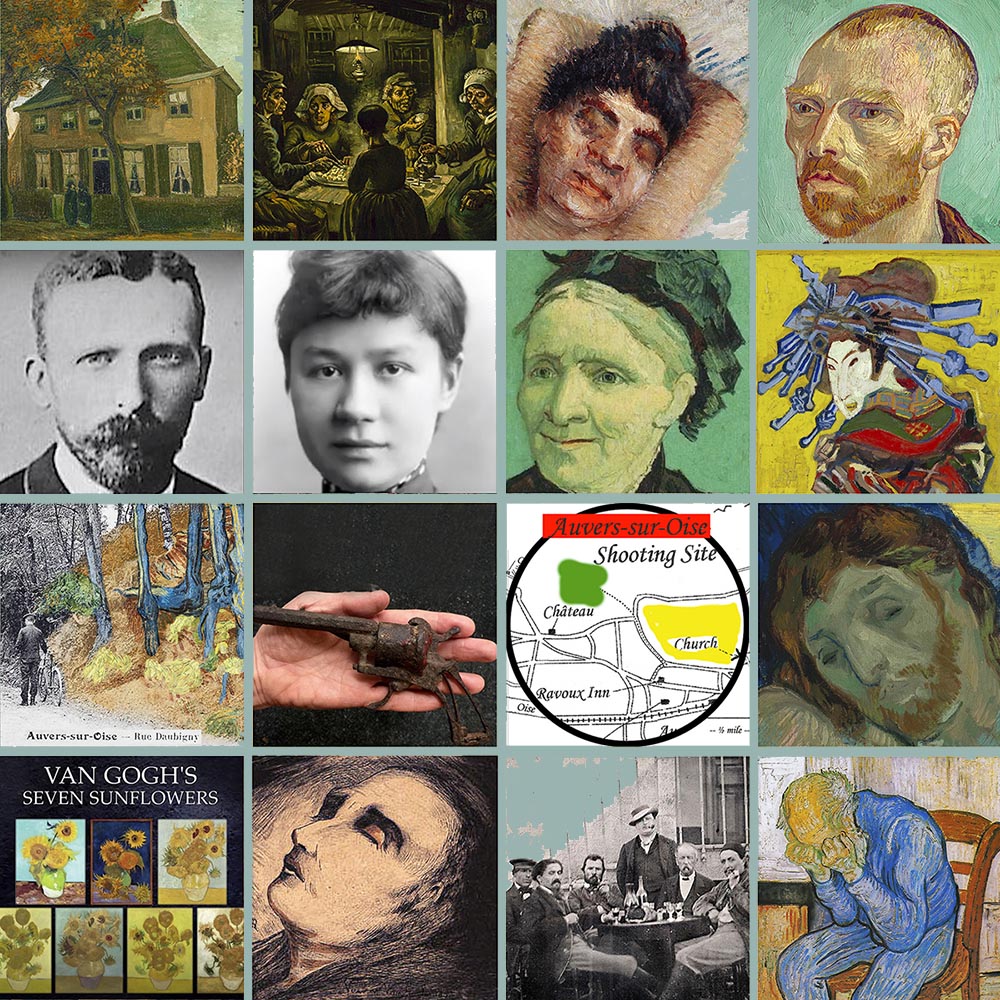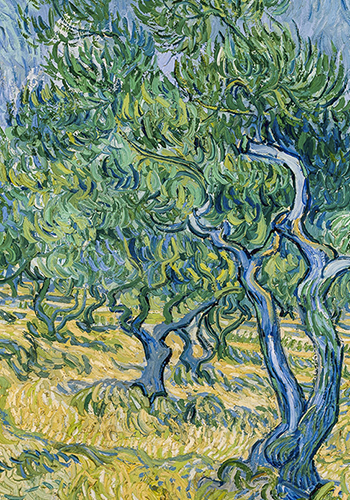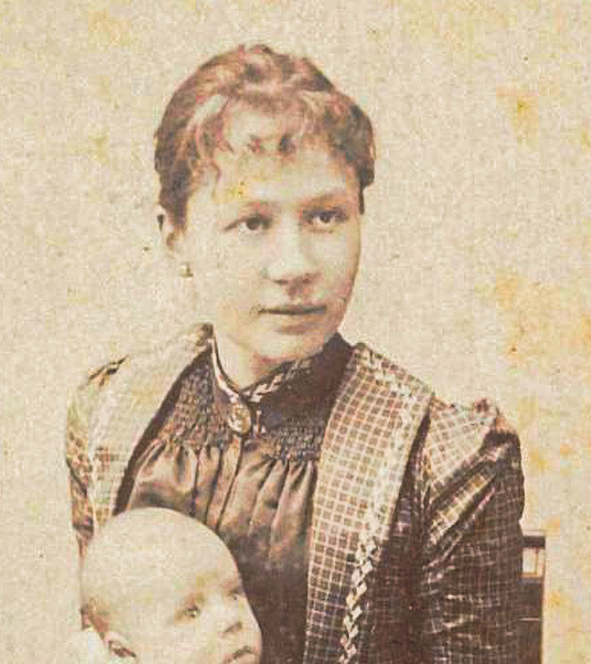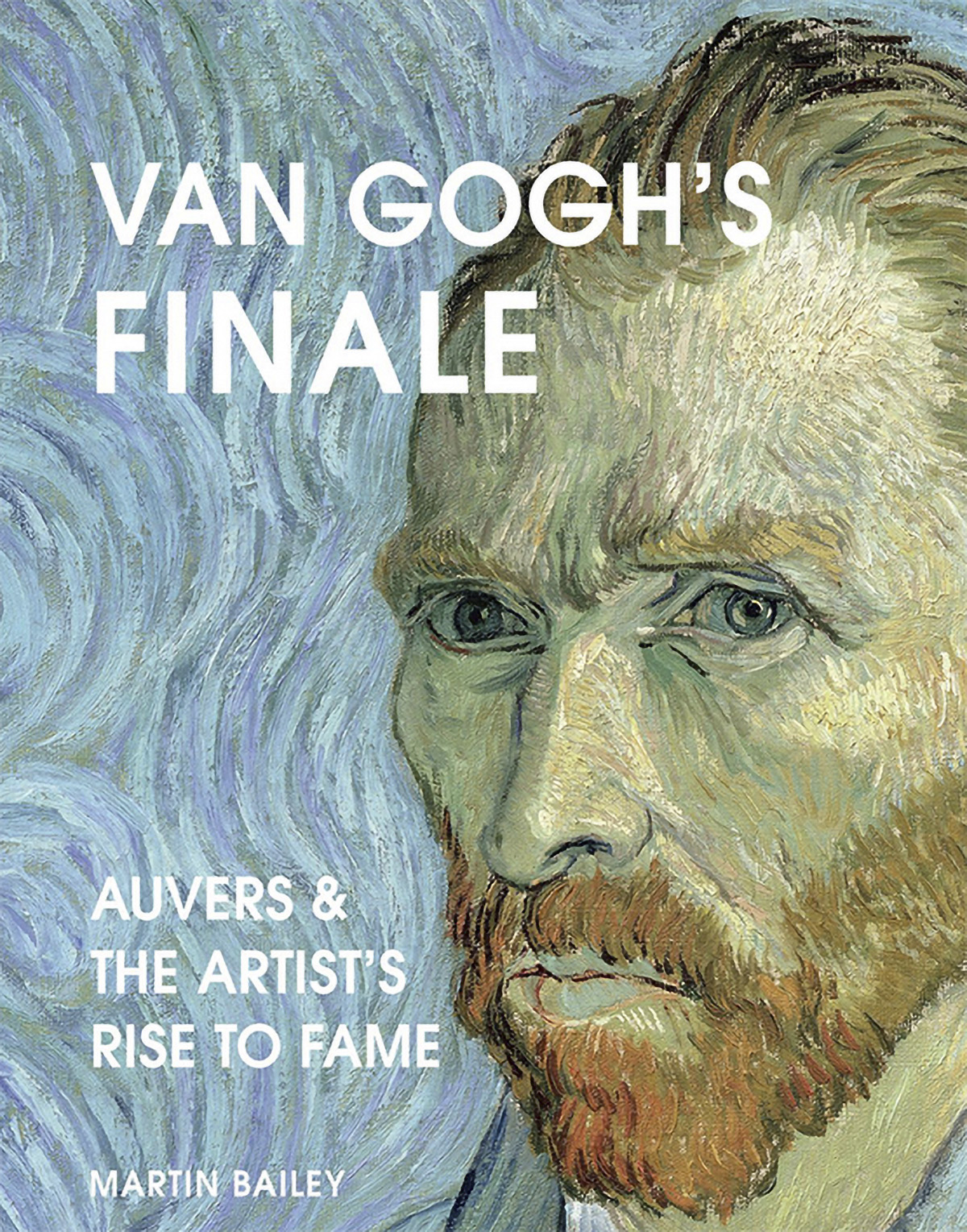

.

Vincent Willem van Gogh, (1853-1890) was a Dutch post-impressionist painter who posthumously became one of the most famous and influential figures in the history of western art. In a decade he created about 2100 artworks, including around 860 oil paintings, most of which date from the last two years of his life. They include landscapes, still lifes, portraits and self-portraits, and are characterised by bold colours and dramatic, impulsive and expressive brushwork that contributed to the foundations of modern art. He was during his life not commercially successful, and his suicide at 37 came after years of illness, depression and poverty.
Born into an upper-middle-class family in the south of Holland, van Gogh drew as a child and was serious, quiet, and thoughtful. As a young man he worked as a rather succesfull art dealer and was often travelling. Vincent, just 20 years of age, was transferred to an art-shop in London where he became depressed after a failed love-affair. He turned to religion and spent time as a Protestant missionary in the Borinage in southern Belgium. He drifted in ill health and solitude before taking up painting in 1881, having moved back home with his parents in Nuenen, a small village in the south of the Netherlands. Theo, his younger brother, supported him financially, and the two kept a life long correspondence by letter, which was years after his death published by his sister-in-law Jo van Gogh-Bonger. His early works, mostly still lifes and depictions of peasant labourers, contain few signs of the vivid colour that distinguished his later work. In 1886, he moved to Paris, where he met inspiring members of the avant-garde, including Émile Bernard and Paul Gauguin, who were reacting against the Impressionist sensibility. It was in Paris where Vincent discovered the power of colour. As his work developed he created a new approach to still lifes and local landscapes. His paintings grew brighter in colour as he developed a style that became fully realised during his stay in Arles in the south of France in 1888 and during his stay in St. Remy in 1889. During this period he broadened his subject matter to include series of olivetrees, wheat fields and sunflowers. Click here and there for bigger pictures.
 |
 |
 |
|---|
Van Gogh suffered from psychotic episodes and delusions and though he worried about his mental stability, he often neglected his physical health, did not eat properly and drank heavily.
His friendship with Gauguin ended after a confrontation with a razor when, in a rage, he severed part of his own left ear. He spent time in psychiatric hospitals, including a year at Saint-Rémy. After he discharged himself and moved to the Auberge Ravoux in Auvers-sur-Oise near Paris, he came under the care of the homeopathic doctor Paul Gachet. Vincent's depression continued and on 27 July 1890 van Gogh shot himself in the chest with a Lefaucheux revolver that was found years later in the very field where he had supposedly fired the gun. Vincent died from his injuries two days after the shooting.
Van Gogh was unsuccessful during his lifetime and he was
considered a
madman and a failure. He became famous after his suicide and in
the public
imagination he exists as a misunderstood genius: the artist
"where discourses
on madness and creativity converge". Six months after Vincent's
death his
brother Theo passed away.The two brothers both had been infected with
syfilis as a result of only God knows what they did in these brothels...  It was thanks to Vincent's sister-in-law that his reputation began to grow. Jo van Gogh-Bonger, the late Theo's wife, driven by love for her late husband, started
after Theo's passing away in January 1891, a relentless and effective crusade to promote the letters between the two brothers as well as the paintings of Vincent whose work attained slowly but steady widespread commercial and popular
success over the ensuing decades. In the early 20th century elements of his
painting-style came to be incorporated by the Fauves and German
Expressionists.
Vincent van Gogh is nowadays remembered as an important but
tragic
painter, whose troubled personality typifies the romantic ideal
of the tortured
artist. He was an unique artistic genius whose signature-images
of sunflowers
and starry nights have won a permanent place in the human
imagination.
Van Gogh's works are today among the world's most expensive
paintings
to have been sold ever. His legacy is also honoured by a museum
in his
name: the Van Gogh Museum, in the center of Amsterdam. Here
you'll
find the world's largest collection of his paintings, drawings
and letters. A picture of the museum here below.
It was thanks to Vincent's sister-in-law that his reputation began to grow. Jo van Gogh-Bonger, the late Theo's wife, driven by love for her late husband, started
after Theo's passing away in January 1891, a relentless and effective crusade to promote the letters between the two brothers as well as the paintings of Vincent whose work attained slowly but steady widespread commercial and popular
success over the ensuing decades. In the early 20th century elements of his
painting-style came to be incorporated by the Fauves and German
Expressionists.
Vincent van Gogh is nowadays remembered as an important but
tragic
painter, whose troubled personality typifies the romantic ideal
of the tortured
artist. He was an unique artistic genius whose signature-images
of sunflowers
and starry nights have won a permanent place in the human
imagination.
Van Gogh's works are today among the world's most expensive
paintings
to have been sold ever. His legacy is also honoured by a museum
in his
name: the Van Gogh Museum, in the center of Amsterdam. Here
you'll
find the world's largest collection of his paintings, drawings
and letters. A picture of the museum here below.


Below: one of the most iconic paintings of Vincent: "Starry Night".
He made this painting during the 1 year stay in St Remy asylum.


See the detail and the impasto-style that Vincent liked so much.



Here below some of the best van Gogh paintings.
Go to the page ARTPRINTS to see them BIGGER





REFERENCES
Go to:
A very interesting movie about Jo Bonger:
https://www.youtube.com/watch?v=ZYqynB1LJ8A
https://www.bloomsbury.com/uk/jo-van-goghbonger-9781350299580/
or see Waldemar movie:
https://www.youtube.com/watch?v=XA_CqvjQWu8
https://www.groene.nl/artikel/kroniek-van-een-aangekondigde-dood
https://en.wikipedia.org/wiki/Vincent_van_Gogh
https://arthive.com/publications/1909~Madness_syphilis_scurvy_Vincent_van_Goghs_medical_history
https://www.aotss.com/did-vincent-vangogh-suffer-from-irlen-syndrome/
An excellent and emotional reading by Ephraim
Rubenstein about
the importance of "the letters" of Vincent and Theo:
https://www.youtube.com/watch?v=U9_iGJQE2us
SMITHSONIAN-ART-NEWS-New Biography Spotlights Jo Bonger, Vincent's sister-in-Law Who Helped Rescue van Gogh From Obscurity.... Below here a painting of Jo Bongers in 1925 by Isaac Israëls.
 Jo Bonger, wife of van Gogh’s brother Theo, described her
mission as
‘getting Vincent’s work seen and appreciated as much
as possible’. Jo Bonger was a force to be reckoned with and we are now
able to tell her life story in great detail. Everything for Vincent:
The Life of Jo van Gogh-Bonger.
Representing the culmination of more than 10 years of
research, according to de
Volkskrant’s Michiel
Kruijt writes "Everything for Vincent" is poised to become the definitive biography of
this largely unheralded character. Bonger, born to a middle-class Dutch family
in October 1862, was working as an English teacher when Theo, reportedly
struck by love at first sight, asked her to marry him. Theo may have been
smitten, but as Artsy’s
Sarah Bochicchio writes, Bonger did not share
the younger van Gogh’s ardent feelings: “I couldn’t say
‘yes’ to
something like that” , she wrote in her diary; following
the 1887 proposal. “... Oh, if only I could, why does my heart
feel nothing for him!" Despite her initial reluctance, Bonger agreed to
continue corresponding with Theo. He eventually won her over, and in 1889, the
pair officially wed. Less than a year later, Bonger gave birth to the couple’s
only child, a son named Vincent Willem, in honor of
Theo’s beloved older brother. Writing for de Volkskrant, Kruijit notes
that Vincent experienced extreme mental health issues in the months
surroundingthe wedding.
In December 1888, the artist had sliced off his own ear
in a fit of
frenzy, and shortly after the ceremony itself, he
attempted suicide.
Although Theo believed Vincent’s condition was
improving by the
spring of 1890, his hopes were soon thwarted: On July
27, the
painter shot himself with a revolver. He died two days
later with
Theo at his bedside. Jo dedicated her life to ensuring
her
brother-in-law's legacy. Van Gogh Museum: "A heartbroken
Theo made it his life’s mission to preserve and promote his
brother’s oeuvre."
Unfortunately, he had very little time to accomplish
this task. Just six
months after van Gogh’s death, Theo followed him to the
grave,
succumbing to the effects of syphilis at age 33.
Bonger, then 28 years old, was left to take care of both
the
couple’s newborn son and her husband’s barely started
campaign.
In her diary written several months after Theo’s
passing, Bonger
reflected on the weighty work that lay ahead: “He has
left me
another task —Vincent’s work— getting it seen and
appreciated
as much as possible”. Although she acknowledged she was
“not
without purpose” , the young widow added, “I do feel
lonely and
abandoned—all the same, there are moments of great
serenity—
that the satisfaction of my work gives me.” Bonger
refused to
simply sell van Gogh’s portfolio and move on with her
life. Instead,
she moved to Bussum, a small Dutch town with a
surprisingly
vibrant artistic community, and started organizing
exhibitions of her
brother-in-law’s works.
Jo Bonger, wife of van Gogh’s brother Theo, described her
mission as
‘getting Vincent’s work seen and appreciated as much
as possible’. Jo Bonger was a force to be reckoned with and we are now
able to tell her life story in great detail. Everything for Vincent:
The Life of Jo van Gogh-Bonger.
Representing the culmination of more than 10 years of
research, according to de
Volkskrant’s Michiel
Kruijt writes "Everything for Vincent" is poised to become the definitive biography of
this largely unheralded character. Bonger, born to a middle-class Dutch family
in October 1862, was working as an English teacher when Theo, reportedly
struck by love at first sight, asked her to marry him. Theo may have been
smitten, but as Artsy’s
Sarah Bochicchio writes, Bonger did not share
the younger van Gogh’s ardent feelings: “I couldn’t say
‘yes’ to
something like that” , she wrote in her diary; following
the 1887 proposal. “... Oh, if only I could, why does my heart
feel nothing for him!" Despite her initial reluctance, Bonger agreed to
continue corresponding with Theo. He eventually won her over, and in 1889, the
pair officially wed. Less than a year later, Bonger gave birth to the couple’s
only child, a son named Vincent Willem, in honor of
Theo’s beloved older brother. Writing for de Volkskrant, Kruijit notes
that Vincent experienced extreme mental health issues in the months
surroundingthe wedding.
In December 1888, the artist had sliced off his own ear
in a fit of
frenzy, and shortly after the ceremony itself, he
attempted suicide.
Although Theo believed Vincent’s condition was
improving by the
spring of 1890, his hopes were soon thwarted: On July
27, the
painter shot himself with a revolver. He died two days
later with
Theo at his bedside. Jo dedicated her life to ensuring
her
brother-in-law's legacy. Van Gogh Museum: "A heartbroken
Theo made it his life’s mission to preserve and promote his
brother’s oeuvre."
Unfortunately, he had very little time to accomplish
this task. Just six
months after van Gogh’s death, Theo followed him to the
grave,
succumbing to the effects of syphilis at age 33.
Bonger, then 28 years old, was left to take care of both
the
couple’s newborn son and her husband’s barely started
campaign.
In her diary written several months after Theo’s
passing, Bonger
reflected on the weighty work that lay ahead: “He has
left me
another task —Vincent’s work— getting it seen and
appreciated
as much as possible”. Although she acknowledged she was
“not
without purpose” , the young widow added, “I do feel
lonely and
abandoned—all the same, there are moments of great
serenity—
that the satisfaction of my work gives me.” Bonger
refused to
simply sell van Gogh’s portfolio and move on with her
life. Instead,
she moved to Bussum, a small Dutch town with a
surprisingly
vibrant artistic community, and started organizing
exhibitions of her
brother-in-law’s works.  By 1900, Bonger had coordinated
around
20 successful shows across Holland; next, she turned her
attention
to the wider art world, collaborating with art dealers,
artists and
museums to publicize van Gogh’s creations. By her death
at
age 62 in 1925, Bailey notes for the Art-Newspaper, Bonger had
spearheaded a major Stedelijk Museum retrospective
featuring
nearly 500 paintings and drawings, sold around 250
original
van Goghs, and published the artist’s extensive letters.
Outside of
her efforts to promote van Gogh’s legacy, Bonger became
engaged
in the political sphere. During a visit to New York in
1917, she
attended a meeting led by communist leader Leon Trotsky,
and in
1905, she co-founded the Amsterdam Social-Democratic
Women’s
Propaganda Club. Her obituary, published in De
Proletarische Vrouw in September 1925, stated: “She always apologized
for not being
more active in the [socialist] movement. She would say
that
bringing her son up properly was also a good thing to do
for society.
‘So that has been my main work.’
Vincent Willem, continued his mother’s work in the
decades following her death. The Van Gogh Museum, established by the
younger Vincent, was to ensure his uncle’s art would remain
accessible to the public indefinitely. The museum opened its doors on June 3,1973.
By 1900, Bonger had coordinated
around
20 successful shows across Holland; next, she turned her
attention
to the wider art world, collaborating with art dealers,
artists and
museums to publicize van Gogh’s creations. By her death
at
age 62 in 1925, Bailey notes for the Art-Newspaper, Bonger had
spearheaded a major Stedelijk Museum retrospective
featuring
nearly 500 paintings and drawings, sold around 250
original
van Goghs, and published the artist’s extensive letters.
Outside of
her efforts to promote van Gogh’s legacy, Bonger became
engaged
in the political sphere. During a visit to New York in
1917, she
attended a meeting led by communist leader Leon Trotsky,
and in
1905, she co-founded the Amsterdam Social-Democratic
Women’s
Propaganda Club. Her obituary, published in De
Proletarische Vrouw in September 1925, stated: “She always apologized
for not being
more active in the [socialist] movement. She would say
that
bringing her son up properly was also a good thing to do
for society.
‘So that has been my main work.’
Vincent Willem, continued his mother’s work in the
decades following her death. The Van Gogh Museum, established by the
younger Vincent, was to ensure his uncle’s art would remain
accessible to the public indefinitely. The museum opened its doors on June 3,1973.

Here below a copy of an internet page showing the paintings that Vincent made in Auvers-sur-Oise. Realize that the paintings are NOT in chronological order. "TreeRoots" should otherwise be on the bottom as TreeRoots is his last painting d.d.July 27th.





Read the full story of Vincent's
final months in a beautiful and well-documented full
color book called "FINALE",
written by Martin Bailey, the famous "van Gogh-connoisseur".
Link to "ArtNewspaper"